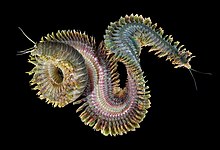Errantia
| Errantia Temporal range: [1]
| |
|---|---|

| |
| Alitta virens | |
| Scientific classification | |
| Domain: | Eukaryota |
| Kingdom: | Animalia |
| Phylum: | Annelida |
| Clade: | Pleistoannelida |
| Subclass: | Errantia Audouin & H Milne Edwards 1832 |
| Orders[2][3] | |
Errantia is a diverse group of marine polychaete worms in the phylum Annelida. Traditionally a subclass of the paraphyletic class Polychaeta,[4] it is currently regarded as a monophyletic group within the larger Pleistoannelida, composed of Errantia and Sedentaria.[2] These worms are found worldwide in marine environments and brackish water.
Phylogeny
[edit]The phylogeny of polychaetes is slowly being resolved. Errantia and Sedentaria are the two biggest clades of polychaetes, and together they compose clade Pleistoannelida.[5] Two groups are nested within Errantia: Aciculata (Eunicida + Phyllodocida) and Protodriliformia (small meiofaunal worms such as the Protodrilida).[6][3][2]
Historically, the order Amphinomida was part of this subclass. However, phylogenetic analyses place Amphinomida inside a basal clade with Sipunculida and Lobatocerebrum, and this clade is the sister group to Pleistoannelida.[3]
Some taxa, such as Spintheridae and Myzostomida, are still difficult to place due to their long branching, but they likely belong to either Errantia or Sedentaria.[3]
Classification
[edit]Historical
[edit]Errantia is, along with Sedentaria, one of the two old orders of the paraphyletic class "Polychaeta". In 1977 the zoologist Kristian Fauchald split Errantia into three orders: Phyllodocida, Amphinomida and Eunicida, giving way to this classification.[7]
- Order Amphinomida – 2 families (Amphinomidae, Euphrosinidae)
- Order Eunicida
- Superfamily Eunicea – 7 families (Onuphidae, Eunicidae, Lumbrineridae, Iphitimidae, Arabellidae, Lysaretidae, Dorvilleidae)
- Superfamily incertae sedis – 2 families (Histriobdellidae, Ichthytomidae)
- Order Phyllodocida
- Suborder Phyllodociformia – 4 families (Phyllodocidae, Alciopidae, Lopadorrhynchidae, Pontodoridae)
- Suborder Aphroditiformia
- Superfamily Aphroditacea – 6 families (Aphroditidae, Polynoidae, Polyodontidae, Pholoididae, Eulepethidae, Sigalionidae)
- Superfamily Chrysopetalacea – 2 families (Chrysopetalidae, Palmyridae)
- Superfamily Pisionacea – 1 family (Pisionidae)
- Suborder Nereidiformia – 6 families (Hesionidae, Pilargiidae, Syllidae, Calamyzidae, Nereididae, Antonbmunidae)
- Suborder Glyceriformia – 3 families (Glyceridae, Goniadidae, Lacydoniidae)
- Suborder incertae sedis – 5 families (Iospilidae, Nephtyidae, Sphaerodoridae, Tomoptendae, Typhloscolecidae)
References
[edit]- ^ Yang, Xiaoyu; Aguado, M. Teresa; Helm, Conrad; Zhang, Zhiqian; Bleidorn, Christoph (April 2024). "New fossil of Gaoloufangchaeta advances the origin of Errantia (Annelida) to the early Cambrian". Royal Society Open Science. 11 (4). doi:10.1098/rsos.231580. ISSN 2054-5703. PMC 11004674. PMID 38601033.
- ^ a b c Struck TH (2019). "Phylogeny". In Purschke G, Böggemann M, Westheide W (eds.). Handbook of Zoology: Annelida. Vol. 1: Annelida Basal Groups and Pleistoannelida, Sedentaria I. De Gruyter. pp. 37–68. doi:10.1515/9783110291582-002. ISBN 9783110291469.
- ^ a b c d Weigert A, Bleidorn C (2016). "Current status of annelid phylogeny". Org Divers Evol. 16 (2): 345–362. doi:10.1007/s13127-016-0265-7.
- ^ "Encyclopedia of Life". Archived from the original on 2010-11-15. Retrieved 2011-06-25.
- ^ Struck TH, Golombek A, Weigert A, Franke FA, Westheide W, Purschke G, Bleidorn C, Halanych KM (3 August 2015). "The evolution of annelids reveals two adaptive routes to the interstitial realm". Curr Biol. 25 (15): 1993–1999. Bibcode:2015CBio...25.1993S. doi:10.1016/j.cub.2015.06.007. PMID 26212885.
- ^ Andrade, Sónia C.S.; Novo, Marta; Kawauchi, Gisele Y.; Worsaae, Katrine; Pleijel, Fredrik; Giribet, Gonzalo; Rouse, Greg W. (November 2015). "Articulating "Archiannelids": Phylogenomics and Annelid Relationships, with Emphasis on Meiofaunal Taxa". Molecular Biology and Evolution. 32 (11): 2860–2875. doi:10.1093/molbev/msv157. PMID 26205969.
- ^ Fauchald, Kristian (3 February 1977), The polychaete worms, definitions and keys to the orders, families and genera (PDF), Science Series, vol. 28, Natural History Museum of Los Angeles County: Los Angeles, CA (USA), pp. 1–188
